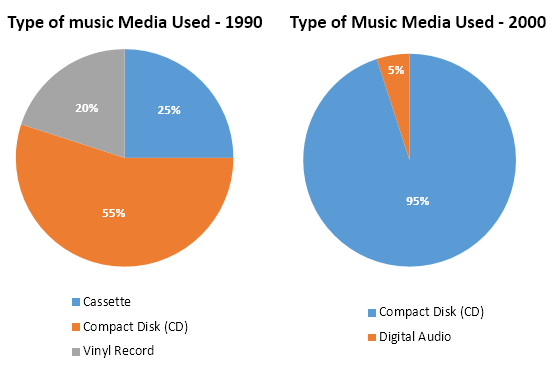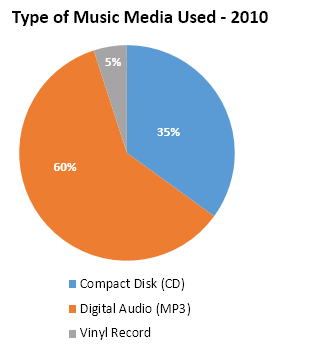» You are advised to spend about 20 minutes on this task.
The pie charts below show the types of music media used from 1990 to 2010. Summarise the information by selecting and reporting the main features, and make comparisons where relevant.
» You should write at least 150 words.


Sample Answer 1
The given diagrams show how the music had been stored and listened to using different storage units in three different decades with a 10 years interval. As can be seen, CD dominated the music storage in the 90s while MP3 became the primary means of music recording in 2010.
As is observed from the given illustration, Compact Disk (abbreviated as CD) was the most widely used storage type to save and retrieve songs in the 90s. In this year more than half of the music was stored and sold using this media. One-quarter use of Cassette for music enlisted it as the second most popular music media in this year while Vinyl Record was used to record the least percentages of music. After ten years, the scenario changed dramatically and Vinyl Record and cassette were no longer used. The CD consumed the whole market and its use increased remarkably to 95% for music. MP3 was introduced in this year but only 5% of its usage to store music reflects its scarcity at that time. Finally, in 2010, MP3, also known as Digital Audio, consumed the market of CD and 60% use of this media indicates its huge popularity in the 2010s. Interestingly the Vinyl Record was back in this decade with its 5% market share to store music while the CD was still the second popular music storage type though observed a significant decrease of its use compared to 10 years ago.
[Written by – Harris]
Sample Answer 2
The given pie charts present information about the storage media which were used to store music in three different years, over a 30-years’ period. It is clear that compact disc was the main media to store music in the early two decades but in 2010 MP3 player became the main media to store music.
In 1990, 55% music storage was done in compact disc (CD) and this figure dramatically increased to 95% in 2000. However, with the dominance of MP3 player, only 35% music storage was done in CDs in 2010. The proportion of using cassettes to store music was 25% in 190 but it became obsolete in later decades. Vinyl Record stored 20% music in 1990 and none in the year 2000. Interestingly it reappeared in 2010 and was used to store 5% music.
Finally, MP3 player, also known as Digital Audio, was not used in 1990 for storing music but it contributed to 5% storage in 2000 and it became the primary storage for music in 2010 with 60% storage of music.
Sample Answer 3
The given pie charts illustrate the comparison of various music media delivery type for the years 1990, 2000 and 2010. According to the given information, Digital Audio (MP3) became the most popular type of music storage and Cassette fade away starting in 2000.
In 1990, over a half of all music was stored on Compact Disc (CD), with 55% of the total music type share over that year. The figures for Cassette and Vinyl Record were very similar with 25% and 20%, respectively. Looking at music storage type in 2000, the most popular form of storage was Compact Disc (CD) with 95% of the portion and a small fraction of 5% remained for Digital Audio (Mp3) in that year. Turning now to the largest music storage kind in 2010, Digital Audio rose significantly from 5% to 60% of the share and Compact Disc (CD) usage dropped considerably from 95% to 35%. Lastly, Vinyl Record accounted for 5% of the music storage portion in that year.
[Written by – Byte]
